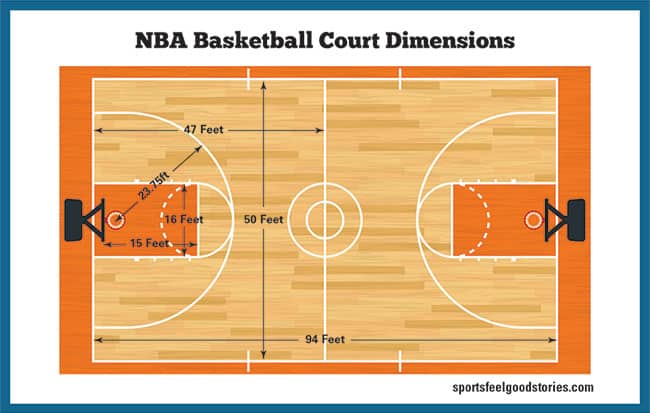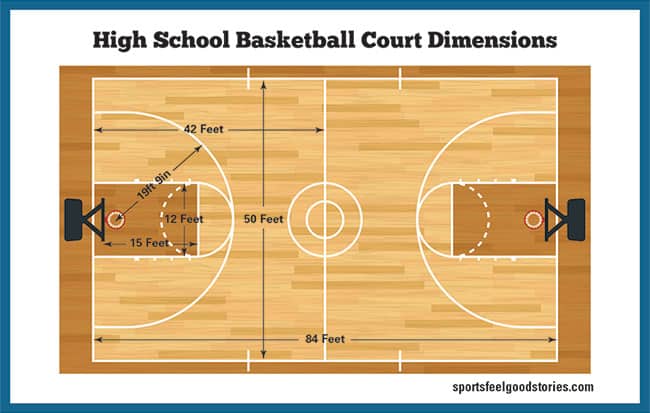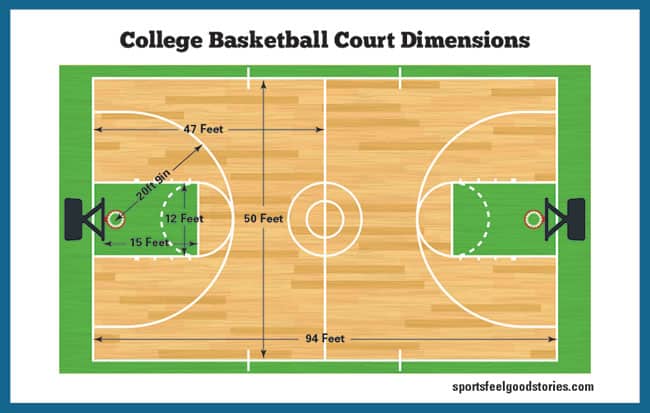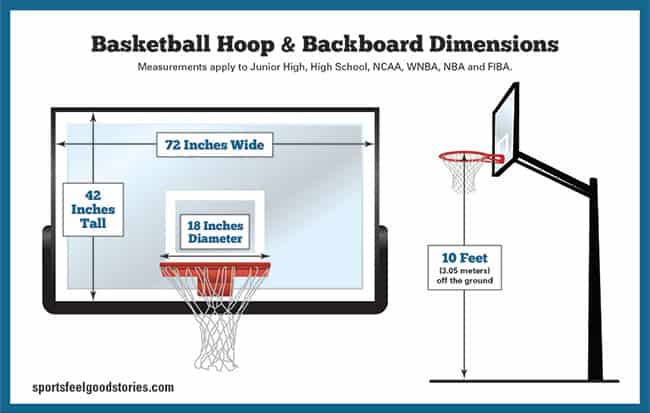Basketball court dimensions and size vary based on the level of play. To help explain the various sizes, we’ve created a chart and diagrams that should help you. Also, if you’d like to add a basketball court to your driveway or backyard, please use this page as a guide for the measurements.
We’ve organized the material into a helpful question-and-answer format. Good luck.
- What is a basketball court size?
- NBA Court Dimensions Diagram
- High school basketball court dimensions
- Basketball Hoop Height and Size
- Basketball Free Throw and 3-Point Distance
- Size of the Basketball
- Backboard, Baseline, and Key
- Core components of basketball courts
- Great Basketball Courts Everyone Should See
- Timing of a Game
- Basketball Court Fun Facts
What is a basketball court size?
Well, it depends on each court you measure — but there are some standards. The age of the players who will be the primary users and budgets are important considerations for court builders.
Basketball Court Dimensions
Regulation basketball court dimensions are 94 feet long by 50 feet wide.
Basketball court size varies depending on the league and level of play. The court measures 94 feet long by 50 feet wide for NBA court dimensions and WNBA and college. Note the paint area – the free throw lane – is 16 feet across. The foul line is 15 feet from the front of the backboard and 2 inches wide.
International Basketball Federation (FIBA) and Olympic basketball courts call for the court to be slightly smaller at 91.9 feet by 49.2 feet. In meters, that’s 28 by 15 meters.
See Caitlin Clark Impresses Basketball World.
NBA Court Dimensions Diagram

High school basketball court dimensions
The high school and junior high basketball gym courts measure 84 feet long by 50 feet wide. Court markings reflect those dimensions.
You might like Kawhi Leonard’s Profile.
High School Basketball Court Diagram

At a younger level of play than college or pro, the court length is 10 feet shorter at 84 feet.
Read all about Larry Bird: Boston Celtic, Star Shooter (and Trash Talker)
How long is a basketball court?
So, what are the court dimensions in feet? The high school court is 84 feet long. The length of an NBA court is exactly 10 feet longer. College and professional league games, including the WNBA, are played on a 94-foot-long court.
One of the most famous college facilities is Pauley Pavilion, where the UCLA Bruins play.
Visit: Stephen A. Smith Profile.
College Basketball Court Diagram

What are court dimensions in meters?
The metric size of a professional court is 28.65 meters long by 15.24 meters wide. The high school court measures 25.6 meters long.
What are half-court dimensions?
Half-court dimensions are 47 feet long for the pros and 42 feet long for high school.
See Basketball Roles and Responsibilities of Each Position.
What are the half-court dimensions for a backyard?
Youth half-court dimensions are usually 42 feet long by 37 feet wide. High school half-courts are slightly larger, 50 feet long by 42 feet wide.
Check out Ben Simmons’s Profile.
What are backyard court dimensions?
Backyard courts can be whatever size you wish (or can fit), but typically they are 90 feet long by 50 feet wide.
What are youth court dimensions – Middle School, Junior High School, and High school?
The middle school court and junior high court sizes are 74 feet long by 42 feet wide. High school courts are slightly larger, at 84 feet long by 50 feet wide.
Looking for a basketball court in your area to play? Check out The Original Basketball Court Finder.

Basketball Hoop Height and Size
It’s critical that you set the goal at the proper height. Here are your guidelines.
See How many teams make the NBA playoffs?
What is the regulation basketball rim height? How tall is a hoop?
The distance from the gym floor to the rim is 10 feet. This rim height is the same for Junior High, High School, NCAA, WNBA, FIBA, and the NBA. Some kids’ leagues will lower the hoop to 8 feet or 9 feet to acknowledge that younger kids have difficulty shooting at ten feet-high hoops.
You might like Jumbotron Dancer Entertains Celtics’ Crowd.
How wide is an NBA basketball hoop? What is the NBA rim size?
The rim size is the same for all game levels – junior high, high school, NCAA, WNBA, NBA, and FIBA – at 18 inches in diameter.

How big is the restricted area in the NBA?
In the NBA, the restricted area is 1.25 meters or just a shade more than four feet in radius under the basket. It is indicated by a dotted line in the shape of an arc. In this area, a charging foul is not called on a defensive player.
Basketball Free Throw and 3-Point Distance
Read the guidelines below carefully, as the three-point distance varies by player.
See How long is a quarter in basketball?
What is the free-throw line distance? How far is the free-throw line?
The free-throw line is measured from the shooting line that intersects the key to the floor directly underneath the backboard. The free throw distance in the NBA, WNBA, and NCAA is 15 feet.
Did you know that Steve Nash was the best percentage shooter of free throws in the NBA? He shot 90.43% from the line making 3,060 of 3,384 attempts.
What is the high school 3-point line distance?
The 3-point semi-circle line for high school is 19.9 feet from the basket.
What is the college’s three-point line distance?
The 3-point line for both NCAA basketball courts – men and women – is set at 20 feet, 9 inches from the hoop.
What is the WNBA three-point line distance?
The WNBA 3-point line is 22.15 feet from the basket. From the corners, the distance is 21.65 feet.
What is the NBA 3-point line distance?
The pros shoot 3-pointers from beyond the arc, 23.75 feet from the basket. From the corners, the distance is 22 feet.
Check out Basketball Slang.
Size of the Basketball
Matching the size of the basketball to the player’s hand size makes a difference. Read on.
What are the ball’s diameter and circumference?
The size of the ball is different for men’s, women’s, and youth leagues.
For the NBA, men’s college, and boys ages 15 and up, players play with a 9.43-9.51 inch diameter (the width measured left to right) basketball. The ball’s circumference (the distance measured around the outside) is 29.5 inches. The official NBA game ball is made by Spalding and measures 9.43-9.51 inches in diameter or 29.5 inches (75cm) in circumference.
NCAA women and the WNBA use a slightly smaller ball with a roughly 9.07-9.23 inch diameter and 28.5-inch circumference.
The ball used in boys’ youth leagues has a 28.5-inch circumference. Girls’ youth basketballs are 27.5 inches in circumference. Kids 5 to 8 years old use the smallest ball at 25.5 inches in circumference.
Backboard, Baseline, and Key
The backboard is four feet from the baseline, marking the end of the players’ active playing surface.
The key is 16 feet wide and 19 feet from the foul line to the baseline.
Inside the key, a four-foot arc is designated to align with the center of the basket to mark the restricted arc. If a defender is within this arc, they cannot draw a charging foul.
Regulation backboards are six feet wide and 42 inches tall.
Free throw markings
Short lines are drawn three feet apart along both sides of the key area to designate the standing positions for rebounders when a free throw is being shot. The first line is drawn seven feet from the baseline.
A six-foot arc (half circle) starting from the free-throw line away from the basket completes the key area.
Core components of basketball courts
Baskets, free-throw lines, three-point arcs, and the half-court line are some of basketball courts’ foundational elements. Court lines mark 94 feet in length by 50 feet in width for NBA courts. The half-court line is at 47 feet. Indoor courts are frequently made of hardwood-like polished maple. Outdoor courts may be composed of asphalt, concrete, or other pavements.
The words baseline and end line both refer to the ends of the court running behind the goals.
In the middle of the half-court line is a tip-off circle that has a six-foot radius. This is where the opening jump ball takes place.
The backcourt refers to the half of the court where the team’s basket is defended. The boundary lines include their end line, sidelines, and the half-court line of the playing court.
For international play, the standard court size is 28m long and 15m wide, measured from the inner edge of the boundary line.
The 3-Point line – Basketball Court Dimensions
The NBA 3-point arc is 22 feet to the center of the rim. Women’s and Men’s college basketball court features a 3-point arc of 20 feet 9 inches. High school basketball courts have a 3-point arc that is 19 feet 9 inches away from the center of the rim.
Great Basketball Courts Everyone Should See
Here are some famous and notable basketball courts you’ll want to check out if you’re a serious hoops fan.
1.) Rucker Park in Harlem, New York. Where street legends go to make their name. Home of Kareem Abdul Jabaar, Nate Archibald, and Connie Hawkins. Even Kevin Durant and Kobe Bryant have made appearances.
2.) United Center, Chicago, Illinois. Michael Jordan won 6 NBA titles while calling this his home court.
3.) Hoosiers Gym in Knightstown, Indiana. Gene Hackman + Dennis Hopper + Picket Fence = the best basketball movie ever.
4.) Pauley Pavilion in Los Angeles, California. Home to the UCLA Bruins and John Wooden’s greatest college hoops dynasty.
5.) Madison Square Garden, Manhattan, New York. Home of the Knicks with a household name that needs no introductions.
6.) The Staples Center in Los Angeles, California. One word: “Showtime!”
7.) The Swim Gym, Beverly Hills High School in Los Angeles. Remember “It’s a Wonderful Life” and the retractable gym floor? This is the place. Built in 1939, a 25-yard pool was placed under the gym floor. It’s a Wonderful Life was a 1946 movie.
Timing of a Game
Here are the total game times for basketball games for each level of play. Remember that time-outs, TV breaks, half-time, and other play stoppages will draw out the real-time of a game 2 to 3 times longer than the timed play.
How long is a high school game?
High school basketball games consist of four 8-minute quarters for 32 minutes of game time.
Length of the college basketball game?
In the NCAA, college games consist of two 20-minute halves for 40 minutes of game time.
How long is a WNBA basketball game?
WNBA basketball games consist of four 10-minute quarters for 40 minutes of game time.
Length of an NBA basketball game?
NBA games consist of four 12-minute quarters for 48 minutes of game time.
How long is the shot clock?
The shot clock requires offenses to shoot before a timed period runs out. If a shot is not made during that period, a shot clock violation is called, and the ball is turned over to the opposing team.
In high school games, the shot clock varies. For men’s college hoops, the shot clock is 35 seconds, and for women’s college is 30 seconds.
The WNBA shot clock is 30 seconds, while the NBA limits the shot clock to only 24 seconds.
Basketball Court Fun Facts
Do you know everything about hoops courts? Try answering these trivia questions.
1.) What type of wood is used for NBA courts?
Maple is selected for its hardness and light color. The lightness helps provide contrast to the ball to follow the action in person and on TV. The lighter color reflects light better, too.
2.) How often does the NBA require teams to replace the floors in the arenas?
Every ten years. But, sometimes, a team receives a waiver if the floor is still in great shape.
3.) What three NBA teams were ranked the highest in appearance by the Chicago Tribune?
Charlotte Hornets, Brooklyn Nets, and Boston Celtics floors were ranked the highest by a panel selected by the newspaper.
By Greg Johnson & Mike O’Halloran
Greg is a designer and writer based in Minneapolis, Minnesota. Mike has authored three books on basketball coaching and has coached ten different teams.
You’re on our Basketball Court Dimensions page.
Further Reading
NBA Players By The Numbers: Wingspans, Verticals, Hand Sizes
